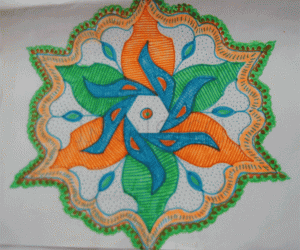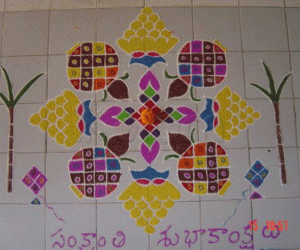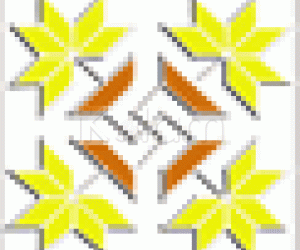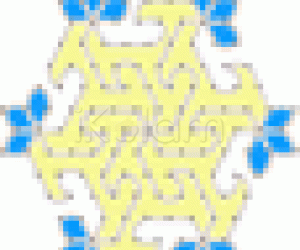This is my own design.
Dots are 13 to 1, inbetween dots. You can use any colours. I have used marker pen and crayons.
Dotted Kolam (connected dots)
- Rangoli kolam
- Kolam - star
- Pongal
- Twinkles 'n' blossoms! rangoli
- Palm leaves rangoli
- Trilobed rangoli
- Rangoli Poster
- Conch rangoli
- Jyothi rangoli
- Diyas rangoli

Deepavali, also known as Diwali, is celebrated by the hindus world-wide. The word "Deepa" means "light" and "avali" means "a row", which makes Deepavali the "festival of light". Traditional Rangoli motifs adorn the frontyards and entryways of every house. People light earthen lamps called "diya" on this day and thank Goddess Lakshmi for the wealth and happiness that she has bestowed upon them. On this day, people visit friends and relatives and also exchange gifts and sweets. Diwali teaches us to drive away the ignorance, the darkness around us and to uphold the true values of life. This Rangoli pattern shown here is an example for anyone who wants to make a Rangoli. After the outlines are drawn, the rangoli is colored with bright powdered dyes/colored sand.

Deepavali / Diwali is celebrated by the hindus world-wide. The word "Deep" means light and "avali" means "a row" which makes Deepavali the "festival of lights". Traditional Rangoli motifs adorn the frontyards and entryways of every house. People light earthen lamps called "diya" on this day and thank the goddess for the wealth and happiness that she has bestowed upon them. On this day, people visit friends and relatives and also exchange gifts and sweets. Diwali teaches us to drive away the ignorance, the darkness around us and to uphold the true values of life. This Rangoli pattern shown here is easy for anyone who wants to make a Rangoli. It has 6 rows of dots altogether and in each row there are 6 dots. The finished design has 4 "diyas" or the clay lamps pointing in different directions. After the outlines are drawn, the diyas are colored with bright colors.








